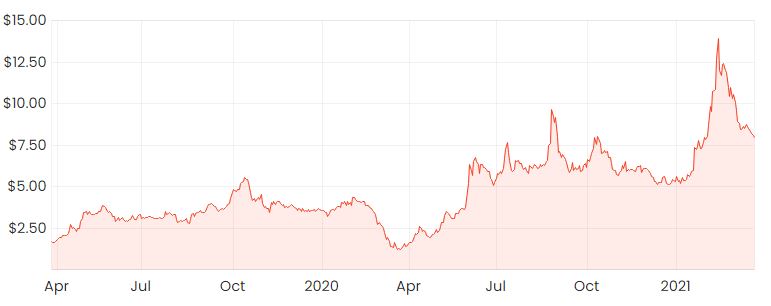For another consecutive week, Buy-now-pay-later (BNPL) Zip Co Ltd (ASX: Z1P) was the most traded share on the ASX last week, with a fairly even split between buyer and seller volume according to CommSec.
The broader BNPL sector definitely seems out of favour at the moment as investors seek opportunities elsewhere.
From the height of the last BNPL rally roughly a month ago, Zip’s share price has fallen 47%, Afterpay Ltd (ASX: APT) shares are down 34%, Splitit Ltd (ASX: SPT) is down 46% and Sezzle Inc (ASX: SZL) has also dropped 36%.
Z1P share price

Why are BNPL shares so volatile?
Despite many BNPL companies reporting extremely strong growth numbers in their recent trading updates, we’re still seeing valuations gradually trend downwards. Why is this happening?
It’s important to remember that shares like Afterpay and Sezzle have still returned over 1100% over the last 12 months. It’s perfectly normal to see corrections such as this as investors take some profits along the way, which puts some downwards pressure on the share price.
The threat of rising bond yields could potentially have adverse consequences on ASX growth shares with lofty valuations.
In the same way that BNPL companies have been beneficiaries of a low interest rate environment, higher real interest rates put downwards pressure on their valuations. This is because higher interest rates increase their cost of borrowing and more discounting is involved in valuation models.
https://education.rask.com.au/2020/01/06/explained-how-to-calculate-weighted-average-cost-of-capital-wacc-in-valuation/
Are BNPL shares cheap?
How do we get a sense of how “cheap” something is?
A low share price? Probably not.
Market capitalisation? This could be better.
The price at which its shares used to trade at? This could also work, but keep in mind that a behavioural bias called “anchoring” is partly causing you to think that shares are cheap relative to what they were trading at before.
This is a common psychological trick that I’ve learnt the hard way. The important question I try and ask myself is: Regardless of what the share was trading at before, does the current price represent good value?
It’s a hard question to ask for such an explosive industry such as BNPL. If you’d like to find out how I value Zip’s shares, click here to read: 1 easy way I value Zip (ASX: Z1P) shares: are they dirt cheap?
For more share ideas, click here to read: 3 ASX growth shares I’d happily buy today.











